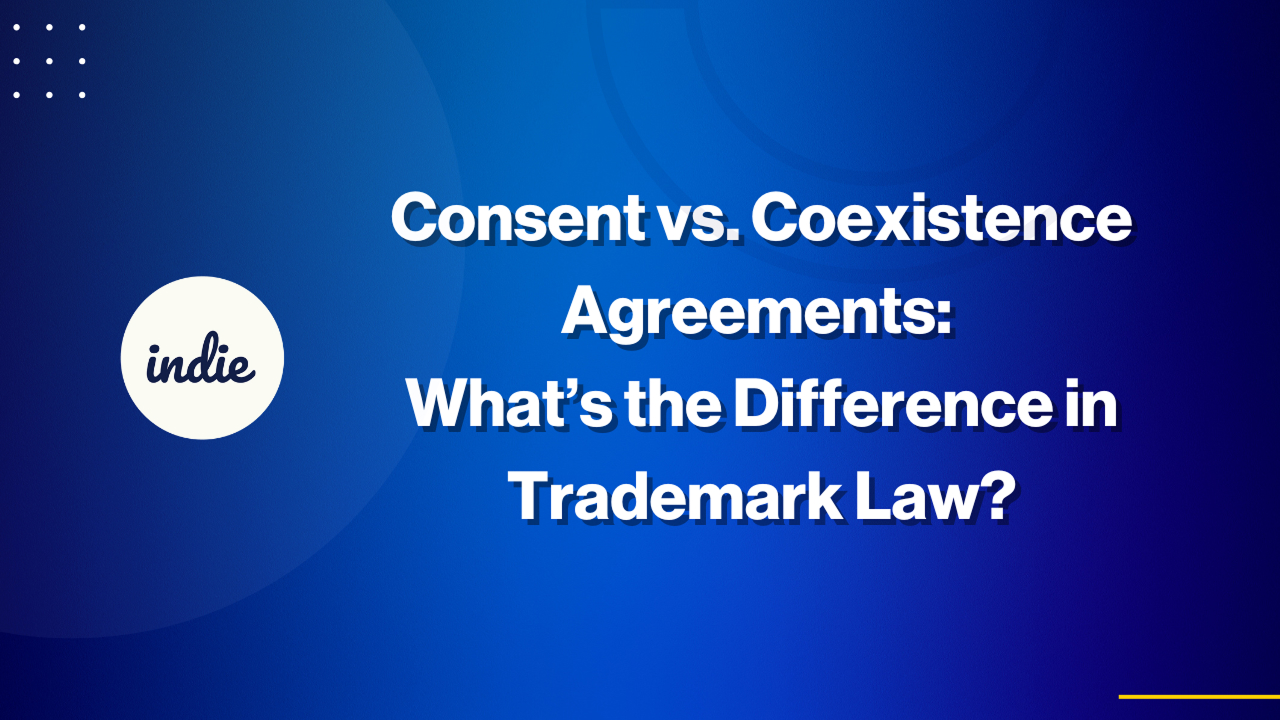You’ve just discovered a similar brand name—now what?
If you’re a small business owner, online entrepreneur, or brand creator, your trademark application could hit a wall if another mark looks or sounds too similar. Thankfully, two common legal tools—trademark consent agreements and coexistence agreements—can help resolve these conflicts and even overcome a USPTO trademark refusal. But these documents aren’t interchangeable.
In this post, you’ll learn:
- What each agreement does
- When and how to use them
- Their pros, cons, and legal weight
- What the USPTO thinks about each
- FAQs answered simply and clearly
Let’s break it all down.
What Is a Trademark Consent Agreement?
A trademark consent agreement is a written agreement where the owner of a registered mark gives permission for another party to register and use a similar trademark. The key legal issue it addresses is likelihood of confusion under Section 2(d) of the Trademark Act (15 U.S.C. §1052(d)).
✅ Purpose: Overcome a USPTO refusal based on conflict with an existing registration.
✅ Use case: When an examining attorney issues a §2(d) refusal during the trademark application process.
Example:
You apply for “Swift Snacks” for protein bars. The USPTO refuses it due to an existing registration for “Swift Sweets” for candy. You reach out to that brand, and they agree your use won’t confuse customers. You both sign a clothed consent agreement explaining why.
The USPTO will often accept this, provided it’s well-reasoned and not just a blanket “we’re cool with it.”
📌 Pro tip: The USPTO gives less weight to “naked” consent agreements—those that lack specifics about why confusion is unlikely (TMEP §1207.01(d)(viii)).
What Is a Coexistence Agreement?
A coexistence agreement is a more detailed contract where two trademark owners agree to use similar marks, usually in different markets, regions, or product categories. It’s a proactive way to avoid litigation—not necessarily a tool to win USPTO approval.
✅ Purpose: Reduce future conflict and define how both parties can operate.
✅ Use case: When similar trademarks already exist in the market and both parties want to avoid a legal dispute.
Example:
One company uses “North Star” for outdoor apparel in the U.S.; another uses “North Star” for hiking gear in Canada. They agree not to enter each other’s territories or file oppositions against each other’s trademarks globally.
📌 Important: Coexistence agreements are not typically accepted by the USPTO unless filed in a concurrent use application or presented in a consent framework.
Consent Agreement vs. Coexistence Agreement: Key Differences
- Purpose
- Consent Agreement: Used to overcome a USPTO refusal due to a “likelihood of confusion.”
- Coexistence Agreement: Used to avoid or settle a potential trademark dispute.
- Legal Weight with the USPTO
- Consent Agreement: Often accepted if detailed and reasoned.
- Coexistence Agreement: Rarely considered by the USPTO unless part of a formal concurrent use proceeding.
- Level of Detail
- Consent Agreement: Moderately detailed; includes usage terms and a statement of no confusion.
- Coexistence Agreement: Highly detailed; includes geography, goods/services, channels, logos, and more.
- Best Use Cases
- Consent Agreement: Ideal for speeding up the registration process.
- Coexistence Agreement: Ideal for long-term brand planning, especially in international or multi-industry contexts.
- Enforceability
- Consent Agreement: Legally binding but usually limited to USPTO proceedings.
- Coexistence Agreement: Stronger legally—can be used in court to define and defend brand rights.
- Speed and Cost
- Consent Agreement: Typically faster and cheaper to prepare.
- Coexistence Agreement: Takes longer to negotiate and draft, but offers broader protection.
What the USPTO Thinks
- Consent agreements are persuasive when they address confusion clearly. The USPTO looks at the totality of the circumstances—a detailed agreement can sway a refusal.
- “Naked” consents (just permission with no reasoning) usually aren’t enough to get a refusal overturned.
- Coexistence agreements are primarily used privately between businesses. They’re rarely submitted to the USPTO unless the applicant is pursuing a concurrent use registration.
When to Use Each Agreement
Consent Agreement:
- You’re facing a USPTO Section 2(d) refusal.
- The other trademark owner agrees your use won’t cause confusion.
- You need a faster, less expensive solution.
Coexistence Agreement:
- Both parties already use similar marks and want to avoid litigation.
- You’re operating in different markets, countries, or product lines.
- You want long-term brand security across classes and geographies.
FAQs
Can I submit a coexistence agreement to the USPTO?
Not typically. The USPTO doesn’t consider these unless part of a concurrent use application. Otherwise, they’re private contracts between brand owners.
Are these agreements legally binding?
Yes. Both are enforceable contracts. Coexistence agreements, due to their depth, are often more robust if disputes arise later.
Do these agreements guarantee USPTO approval?
No. The USPTO isn’t required to accept either. However, a well-drafted clothed consent agreement can significantly improve your chances.
Should I use a lawyer to draft one?
Absolutely. Poorly written agreements can be unenforceable or rejected. A trademark attorney can ensure your agreement meets legal standards and strategic needs.
Final Thoughts
- A trademark consent agreement is your go-to tool for overcoming USPTO refusals and moving your application forward.
- A coexistence agreement is your best bet for long-term protection and peace of mind in the marketplace.
If you’re trying to protect your brand, expand your business, or avoid costly legal headaches, choosing the right agreement is critical.
Need Help?
Facing a USPTO trademark refusal or trademark conflict? We help businesses craft smart, enforceable agreements to protect their brand and avoid legal landmines.
Let’s talk. Contact us today and we’ll guide you through your best options.

